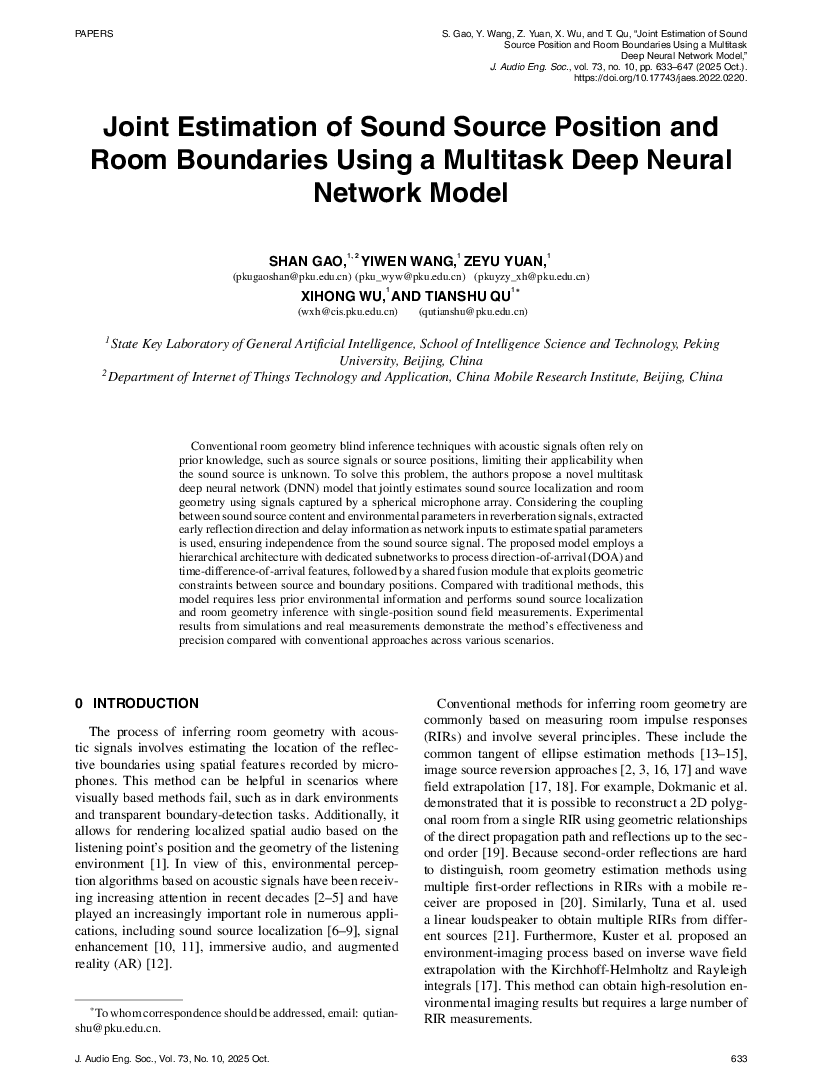Home / Publications / E-library page
You are currently logged in as an
Institutional Subscriber.
If you would like to logout,
please click on the button below.
Home / Publications / E-library page
Only AES members and Institutional Journal Subscribers can download
Conventional room geometry blind inference techniques with acoustic signals often rely on prior knowledge, such as source signals or source positions, limiting their applicability when the sound source is unknown. To solve this problem, the authors propose a novel multitask deep neural network (DNN) model that jointly estimates sound source localization and room geometry using signals captured by a spherical microphone array. Considering the coupling between sound source content and environmental parameters in reverberation signals, extracted early reflection direction and delay information as network inputs to estimate spatial parameters is used, ensuring independence from the sound source signal. The proposed model employs a hierarchical architecture with dedicated subnetworks to process direction-of-arrival (DOA) and time-difference-of-arrival features, followed by a shared fusion module that exploits geometric constraints between source and boundary positions. Compared with traditional methods, this model requires less prior environmental information and performs sound source localization and room geometry inference with single-position sound field measurements. Experimental results from simulations and real measurements demonstrate the method’s effectiveness and precision compared with conventional approaches across various scenarios.
Author (s): Gao, Shan; Wang, Yiwen; Yuan, Zeyu; Wu, Xihong; Qu, Tianshu
Affiliation:
State Key Laboratory of General Artificial Intelligence, School of Intelligence Science and Technology, Peking University, Beijing, China; State Key Laboratory of General Artificial Intelligence, School of Intelligence Science and Technology, Peking University, Beijing, China; State Key Laboratory of General Artificial Intelligence, School of Intelligence Science and Technology, Peking University, Beijing, China; State Key Laboratory of General Artificial Intelligence, School of Intelligence Science and Technology, Peking University, Beijing, China; State Key Laboratory of General Artificial Intelligence, School of Intelligence Science and Technology, Peking University, Beijing, China; Department of Internet of Things Technology and Application, China Mobile Research Institute, Beijing, China
(See document for exact affiliation information.)
Publication Date:
2025-10-01
Import into BibTeX
Permalink: https://aes2.org/publications/elibrary-page/?id=23026
(1168KB)
Click to purchase paper as a non-member or login as an AES member. If your company or school subscribes to the E-Library then switch to the institutional version. If you are not an AES member Join the AES. If you need to check your member status, login to the Member Portal.

Gao, Shan; Wang, Yiwen; Yuan, Zeyu; Wu, Xihong; Qu, Tianshu; 2025; Joint Estimation of Sound Source Position and Room Boundaries Using a Multitask Deep Neural Network Model [PDF]; State Key Laboratory of General Artificial Intelligence, School of Intelligence Science and Technology, Peking University, Beijing, China; State Key Laboratory of General Artificial Intelligence, School of Intelligence Science and Technology, Peking University, Beijing, China; State Key Laboratory of General Artificial Intelligence, School of Intelligence Science and Technology, Peking University, Beijing, China; State Key Laboratory of General Artificial Intelligence, School of Intelligence Science and Technology, Peking University, Beijing, China; State Key Laboratory of General Artificial Intelligence, School of Intelligence Science and Technology, Peking University, Beijing, China; Department of Internet of Things Technology and Application, China Mobile Research Institute, Beijing, China; Paper ; Available from: https://aes2.org/publications/elibrary-page/?id=23026
Gao, Shan; Wang, Yiwen; Yuan, Zeyu; Wu, Xihong; Qu, Tianshu; Joint Estimation of Sound Source Position and Room Boundaries Using a Multitask Deep Neural Network Model [PDF]; State Key Laboratory of General Artificial Intelligence, School of Intelligence Science and Technology, Peking University, Beijing, China; State Key Laboratory of General Artificial Intelligence, School of Intelligence Science and Technology, Peking University, Beijing, China; State Key Laboratory of General Artificial Intelligence, School of Intelligence Science and Technology, Peking University, Beijing, China; State Key Laboratory of General Artificial Intelligence, School of Intelligence Science and Technology, Peking University, Beijing, China; State Key Laboratory of General Artificial Intelligence, School of Intelligence Science and Technology, Peking University, Beijing, China; Department of Internet of Things Technology and Application, China Mobile Research Institute, Beijing, China; Paper ; 2025 Available: https://aes2.org/publications/elibrary-page/?id=23026
@article{gao2025joint,
author={gao shan and wang yiwen and yuan zeyu and wu xihong and qu tianshu},
journal={journal of the audio engineering society},
title={joint estimation of sound source position and room boundaries using a multitask deep neural network model},
year={2025},
volume={73},
issue={10},
pages={633-647},
month={october},}
TY – paper
TI – Joint Estimation of Sound Source Position and Room Boundaries Using a Multitask Deep Neural Network Model
SP – 633 EP – 647
AU – Gao, Shan
AU – Wang, Yiwen
AU – Yuan, Zeyu
AU – Wu, Xihong
AU – Qu, Tianshu
PY – 2025
JO – Journal of the Audio Engineering Society
VO – 73
IS – 10
Y1 – October 2025